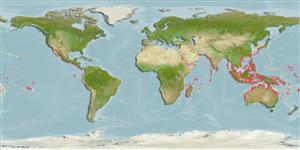>
Anguilliformes (Eels and morays) >
Ophichthidae (Snake eels) > Ophichthinae
Etymology: Pisodonophis: Greek, piso, pipisko = to drink + Greek, odous = teeth + Greek, ophis = serpent.
More on author: Richardson.
Environment: milieu / climate zone / distribuzione batimetrica / distribution range
Ecologia
marino; acqua dolce; salmastro associati a barriera corallina; anadromo (Ref. 51243); distribuzione batimetrica 1 - 20 m (Ref. 90102). Tropical
Indo-Pacific: Red Sea and East Africa to French Polynesia, north to the Ogasawara Islands, south to Australia.
Size / Peso / Age
Maturità: Lm ? range ? - ? cm
Max length : 108 cm TL maschio/sesso non determinato; (Ref. 1479); common length : 50.0 cm TL maschio/sesso non determinato; (Ref. 7245)
Short description
Chiavi di identificazione | Morfologia | Morfometria
Spine dorsali (totale) : 0; Spine anali: 0; Vertebre: 152 - 163. Teeth molariform, multiserial on jaws, intermaxillary and vomer; dorsal fin with broad dark edge (Ref. 37816). Dorsal fin beginning above pectoral fin (Ref. 12693). Body snake-like, cylindrical, compressed only along extreme tail tip; anterior nostril tubular, posterior nostril along lower edge of lip; median fins not continuous posteriorly; extreme tip of tail stiff and finless; dorsal fin origin over front to middle portion of pectoral fins; lateral line inconspicuous (Ref. 4832). Variable from grey to black or brown. Large individuals have wrinkled skin (Ref. 48635).
Body shape (shape guide): eel-like; Cross section: circular.
Occurs in lagoons and estuaries, entering freshwater (Ref. 12693). Often in tidal channels where loose groups congregate, and usually seen with just the head exposed (Ref. 48635). Caught most often in tidal areas and estuaries (Ref. 12693). Caught in bag nets and similar gear. Marketed fresh (Ref. 7050).
Life cycle and mating behavior
Maturità | Riproduzione | Deposizione | Uova | Fecundity | Larve
McCosker, J.E. and P.H.J. Castle, 1986. Ophichthidae. p. 176-186. In M.M. Smith and P.C. Heemstra (eds.) Smiths' sea fishes. Springer-Verlag, Berlin. (Ref. 3972)
IUCN Red List Status (Ref. 130435: Version 2025-1)
Threat to humans
Harmless
Human uses
Pesca: scarso interesse commerciale
Strumenti
Special reports
Download XML
Fonti Internet
Estimates based on models
Preferred temperature (Fonte Biblio.
123201): 24.2 - 29.3, mean 28.4 °C (based on 3721 cells).
Phylogenetic diversity index (Fonte Biblio.
82804): PD
50 = 0.5039 [Uniqueness, from 0.5 = low to 2.0 = high].
Bayesian length-weight: a=0.00063 (0.00033 - 0.00121), b=3.01 (2.84 - 3.18), in cm total length, based on LWR estimates for this species & (Sub)family-body (Ref.
93245).
Trophic level (Fonte Biblio.
69278): 3.8 ±0.6 se; based on size and trophs of closest relatives
Resilienza (Fonte Biblio.
120179): Medio, tempo minimo di raddoppiamento della popolazione 1.4 - 4.4 anni (Preliminary K or Fecundity.).
Fishing Vulnerability (Ref.
59153): High vulnerability (65 of 100).
🛈
Nutrients (Ref.
124155): Calcium = 30.8 [17.2, 57.1] mg/100g; Iron = 0.457 [0.272, 0.847] mg/100g; Protein = 19.1 [16.9, 21.7] %; Omega3 = 0.101 [0.046, 0.277] g/100g; Selenium = 38.2 [21.5, 73.7] μg/100g; VitaminA = 42.4 [12.8, 137.4] μg/100g; Zinc = 1.05 [0.75, 1.48] mg/100g (wet weight);
